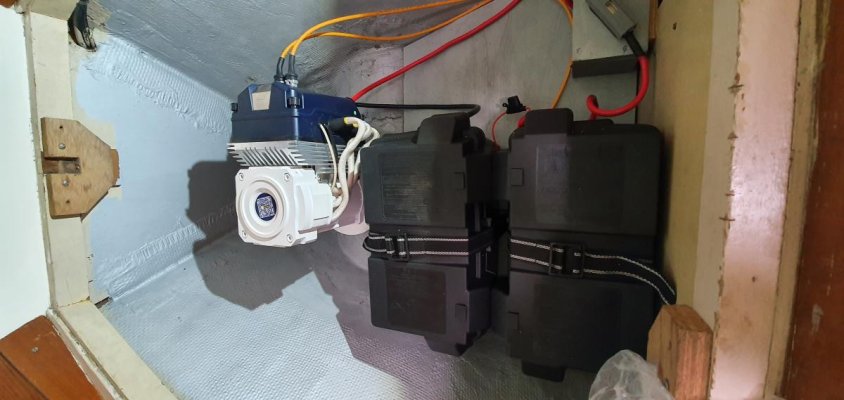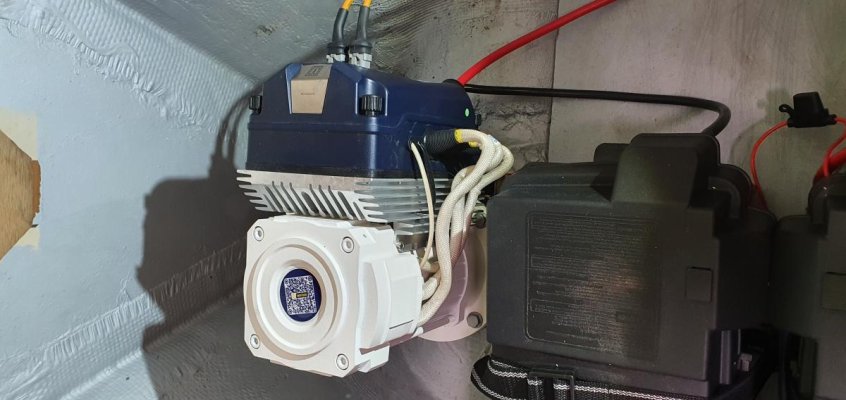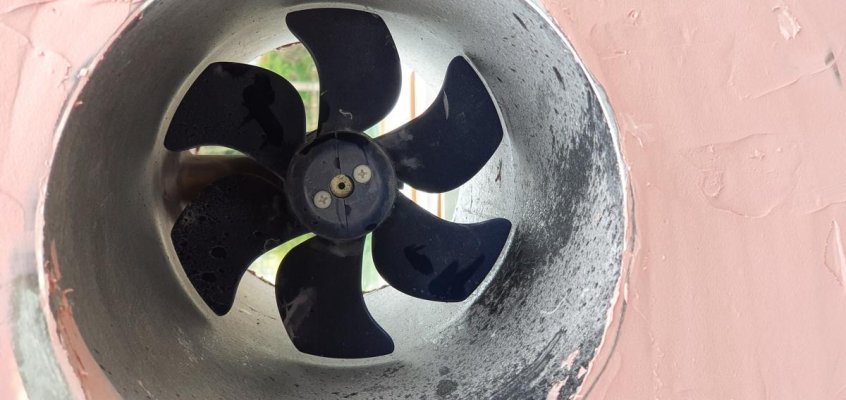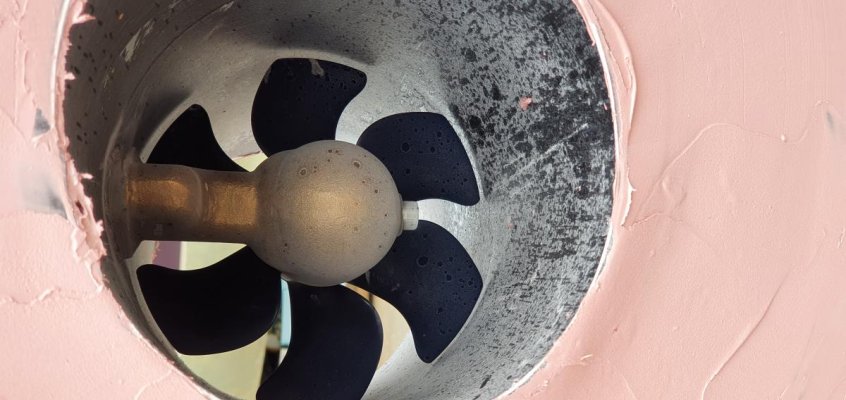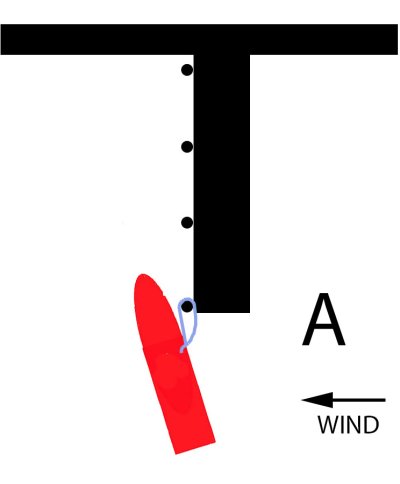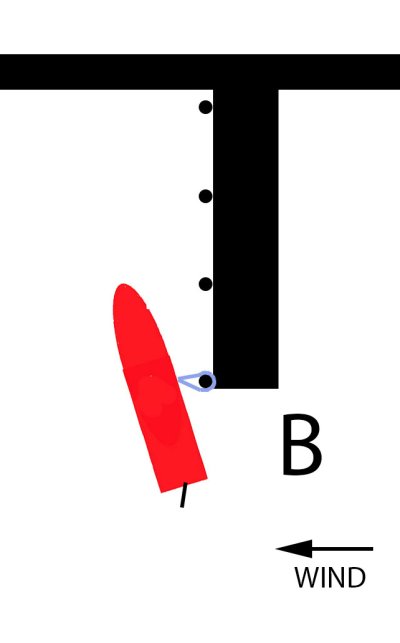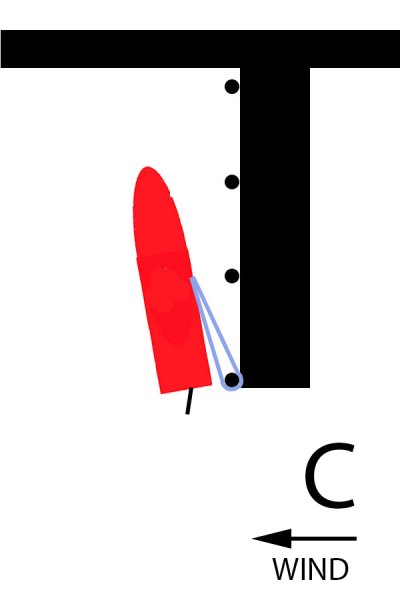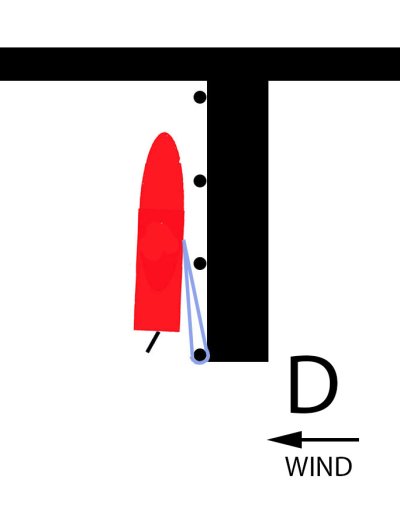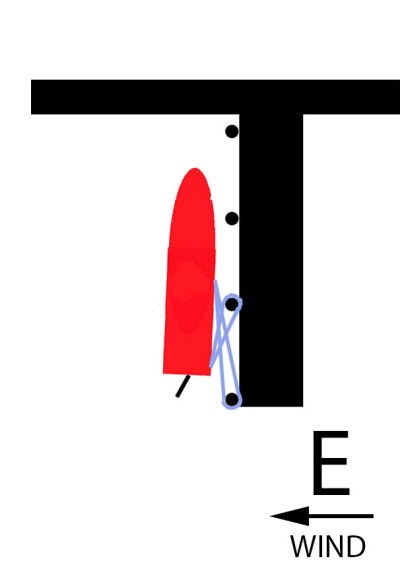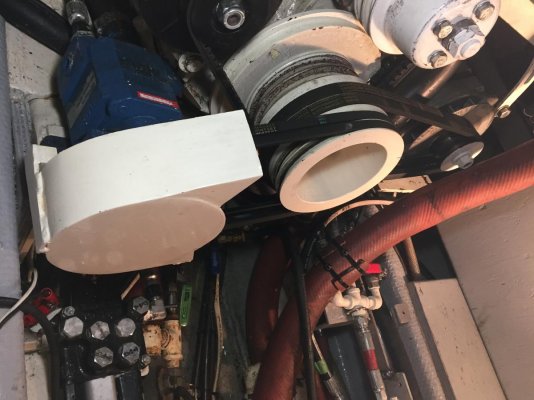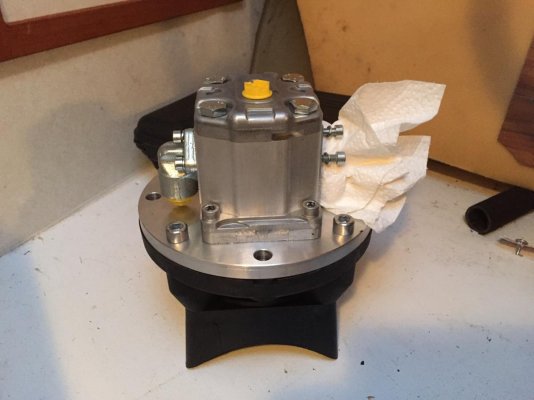Was the flight of 12 on the Nivernais? I've followed this thread with interest. There are some highly sophisticated solutions to a simple problem. My simple answer: no, don't do it. In some locks, the flood when the water levels change can be very intense. I'm not sure any thruster is going to reliably hold to the wall in a big churn. My experience has been French & Dutch waterways, the Erie and the Trent-Severn. I can't think of any authorities who would let you use this technique. And in some waterways in high season, the hire boats are like bumper cars; nothing like a firm line in those circumstances.
You are using an out of date browser. It may not display this or other websites correctly.
You should upgrade or use an alternative browser.
You should upgrade or use an alternative browser.
Thruster questions
- Thread starter FatBear
- Start date
The friendliest place on the web for anyone who enjoys boating.
If you have answers, please help by responding to the unanswered posts.
If you have answers, please help by responding to the unanswered posts.
captmikem
Veteran Member
Bear in mind with a hydraulic thruster if the pump is on the main engine in order to get any power to the thruster you need to bring up the turns (RPM), which when docking is a bit cumbersome. I have had two boats with hyd thrusters that had the pump on the main engine, an 80' sailboat and a 151 ft trawler. It was not an easy thing balancing RPM to get thrust power while maneuvering. If you do go with hydraulics (which is good) I highly suggest you mount the pump on the gen set.
I also had a small sailboat (46') with an electric thruster. It worked well as I never used it for more than about 10 seconds at a time, usually much less. However, one time backing into a travel lift with a side current I used it for about 15 or 20 seconds and melted a post on one of the batteries. It had two dedicated batteries in the bow for the thruster and windlass.
I can not imagine a stern thruster on a small boat. the room etch it would take up would just not be worth it.
I had bow and retractable stern thruster on a 154' sailboat. I rarely used the stern thruster as it was much easier to use the main engine/rudder to bring the stern in.
Hope this helps, good luck with your new boat.
M
I also had a small sailboat (46') with an electric thruster. It worked well as I never used it for more than about 10 seconds at a time, usually much less. However, one time backing into a travel lift with a side current I used it for about 15 or 20 seconds and melted a post on one of the batteries. It had two dedicated batteries in the bow for the thruster and windlass.
I can not imagine a stern thruster on a small boat. the room etch it would take up would just not be worth it.
I had bow and retractable stern thruster on a 154' sailboat. I rarely used the stern thruster as it was much easier to use the main engine/rudder to bring the stern in.
Hope this helps, good luck with your new boat.
M
I have a bow and stern Sidepower thruster with a remote. It works fine from the dock (although the range is a bit short if I walk forward). I think bursts from the remote is easier than trying to get the variable speed right at the helm and then leave the control to step ashore. And when lines are secure you don't have to run back to the helm to turn it off.
However the vast majority of the time our docking technique is for my wife to drop a line over a cleat that is tied to a stern quarter cleat (about 3/4s of the way back). The line only used for docking and is premeasured so that the dock cleat ends up about 2' astern of the boat. Once it goes taught, I leave the engine in slow forward to keep the boat pinned to the dock and I step ashore to put on other lines.
My wife prefers the docking stick to grab the cleat. Takes no strain or effort.
I can also use the docking stick singlehanded to drop the line. Or leave the helm to my wife for the last bit of the approach while I do it. The line is only 7/16" and very light. I replace it with a heavier dock line once things settle down. The trick is to have a cleat the right distance back so your boat under power sits squarely against the dock. May require a new cleat.
However the vast majority of the time our docking technique is for my wife to drop a line over a cleat that is tied to a stern quarter cleat (about 3/4s of the way back). The line only used for docking and is premeasured so that the dock cleat ends up about 2' astern of the boat. Once it goes taught, I leave the engine in slow forward to keep the boat pinned to the dock and I step ashore to put on other lines.
My wife prefers the docking stick to grab the cleat. Takes no strain or effort.
I can also use the docking stick singlehanded to drop the line. Or leave the helm to my wife for the last bit of the approach while I do it. The line is only 7/16" and very light. I replace it with a heavier dock line once things settle down. The trick is to have a cleat the right distance back so your boat under power sits squarely against the dock. May require a new cleat.
Last edited:
Carlr219
Member
Thrustor Configuration
Short of "re-training" you crew I have a configuration that works quite well.
HYDRAULIC bow and stern thrusters, I believe this to be a must! Prolong use with electric due to a sustained wind will cause you to lose power quickly and probably get into trouble. Getting promotional controls will be extremely beneficial. I use ABT System.,
I also have a YACHT Controller. This enables me to operate the trusters as well as the engines when I need to. The engine controls work at idle speed. I do not have the type which allows complete control.
These controls are also extremely beneficial when having to dock without assistance.
This is the second boat Ive configure this way and it works reliably every time.
Short of "re-training" you crew I have a configuration that works quite well.
HYDRAULIC bow and stern thrusters, I believe this to be a must! Prolong use with electric due to a sustained wind will cause you to lose power quickly and probably get into trouble. Getting promotional controls will be extremely beneficial. I use ABT System.,
I also have a YACHT Controller. This enables me to operate the trusters as well as the engines when I need to. The engine controls work at idle speed. I do not have the type which allows complete control.
These controls are also extremely beneficial when having to dock without assistance.
This is the second boat Ive configure this way and it works reliably every time.
Thrusters
I highly recommend having thrusters - bow & stern. Your wife will thankyou.
Biggest mistake is not getting one that is powerful enough ! Don't skimp !
How big ? - Minimum size 10 HP at each end of boat - MINIMIUM -!
Next - Also make all your lines with spliced in loops & have them set up for the exact correct length for prefect docking which is faster & easier to use for home slip docking & your crew will thank you.
Next - I recommend also to get a pair of marriage saver head sets so easy communications & normal talking can be done with crew. NO SHOUTING !
On a 40 to 45 footer, Hydraulic is not, in my experience, the way to go.
IMHO - Any Hydraulic pump running off your main engine is a mistake ! -
My 42 had a Bow Thruster that was hydraulic off the main engine & I was not happy with it at all !
I don't have room to tell you all the bad things about that experience.
I live just north of L.A. & your in San Diego - maybe you can come up to visit some time on a weekend. - it is about a 3 hour drive on a weekend morning to swing up & I would be happy to show you a bit about thrusters, which I have bow & stern, on my KK-42.
PM me if your interested. ---
Bring your wife if you like.
We will make it fun.
We can do lunch on board.
Couple lessons -
I Recommend to go with 24 volts for your thrusters - NOT 12 volts.
Go for max HP you can get - bigger is better always with thrusters, can't be too big ! You can also go to a 24 V windless at same time & you will love it.
You don't need variable speed, if it is expensive - pass. On off works just fine.
A wireless remote control is nice if you can get one without breaking the bank.
- for a 40 footer 13 to 15 HP is about right size for Bow & same HP for Stern.
Don't skimp on the batteries - USE Starting AGM's - group 31's - work well.
4 Batteries at each end is right capacity, in a "Series - Parallel" wiring set up.
Don't have both thrusters running off same batteries ever.
Keep then separate !
Use a separate set of batteries at each end of the boat to keep the cable running lengths short as possible. It makes a difference.
For recharging the 24 volt battery system for thrusters, use a B to B charger off your house batteries. That sure simplifies everything a lot.
if you want a small smart charger - like a 6 amp size would be good, as a stand alone dock trickle charger, if you have a preference for that type set up
Good Luck.
Alfa Mike
I highly recommend having thrusters - bow & stern. Your wife will thankyou.
Biggest mistake is not getting one that is powerful enough ! Don't skimp !
How big ? - Minimum size 10 HP at each end of boat - MINIMIUM -!
Next - Also make all your lines with spliced in loops & have them set up for the exact correct length for prefect docking which is faster & easier to use for home slip docking & your crew will thank you.
Next - I recommend also to get a pair of marriage saver head sets so easy communications & normal talking can be done with crew. NO SHOUTING !
On a 40 to 45 footer, Hydraulic is not, in my experience, the way to go.
IMHO - Any Hydraulic pump running off your main engine is a mistake ! -
My 42 had a Bow Thruster that was hydraulic off the main engine & I was not happy with it at all !
I don't have room to tell you all the bad things about that experience.
I live just north of L.A. & your in San Diego - maybe you can come up to visit some time on a weekend. - it is about a 3 hour drive on a weekend morning to swing up & I would be happy to show you a bit about thrusters, which I have bow & stern, on my KK-42.
PM me if your interested. ---
Bring your wife if you like.
We will make it fun.
We can do lunch on board.
Couple lessons -
I Recommend to go with 24 volts for your thrusters - NOT 12 volts.
Go for max HP you can get - bigger is better always with thrusters, can't be too big ! You can also go to a 24 V windless at same time & you will love it.
You don't need variable speed, if it is expensive - pass. On off works just fine.
A wireless remote control is nice if you can get one without breaking the bank.
- for a 40 footer 13 to 15 HP is about right size for Bow & same HP for Stern.
Don't skimp on the batteries - USE Starting AGM's - group 31's - work well.
4 Batteries at each end is right capacity, in a "Series - Parallel" wiring set up.
Don't have both thrusters running off same batteries ever.
Keep then separate !
Use a separate set of batteries at each end of the boat to keep the cable running lengths short as possible. It makes a difference.
For recharging the 24 volt battery system for thrusters, use a B to B charger off your house batteries. That sure simplifies everything a lot.
if you want a small smart charger - like a 6 amp size would be good, as a stand alone dock trickle charger, if you have a preference for that type set up
Good Luck.
Alfa Mike
Last edited:
ramkay
Veteran Member
Just replaced my hydraulic bow thruster on my GB32 with an electric Vetus 130 BOW PRO, which is good for boats up to 65'. Very happy with it and you can keep it going for 10 minutes at variable thrusts. It has a lockdown for the speed you want and it has a built in battery charger. This is the top of the line model and I highly recommend it. BTW I'm in France and I do very many locks on daily basis and my wife loves it now, no more strain on her muscles and I can take the boat out in any weather alone and Dock it nicely. vetus.com
Handling lines and bow thrusters - I feel your pain
As the Admiral, I’ve been in your exact shoes since I had 4 shoulder surgeries within one year on a 44 ft trawler. Here’s my 2 cents.
Don’t rely on your bowthrusters. They will fail your expectations at the worst possible time and with your wife’s shoulder issue it could mean disaster, injury, or expensive damage. Even with the big side powers, some cross winds were just too much for them.
Option 1.
You need to help her learn the helm and the thrusters and you need to take the lines. With her injury and her reluctance, you risk her falling overboard, or dropping a line and getting them caught in the prop. Your side powers won’t help you there. And for heavens sake, don’t give her directions in the middle of maneuvers. Trust her and do your job.
Option 2.
Let her handle the lines and modify what I did so it works.
I chose to handle the lines during my shoulder recoveries on our 44 ft trawler and here’s how. I got to choose the line by location and length and feel. The softer, the better on my hands and for throwing. Also they were kept in their exact positions, with the length needed, ready to go, belayed on cleats, never put away. A set on each side, in case things changed at the last minute. Also have a clear plan which line gets thrown first. I always did the midship/spring line then the rear and the helmsman could control the bow and the forward/aft boat movement. This gave me time to saunter forward and throw the forward line. Don’t rely on the dock people to tell her which line, they don’t know your boat and although some are great, not all know what to do. She needs to tell them. In preparation, I laid each line in a figure 8 on each side of the bow, midship and aft, over the rails so I didn’t have to fiddle with getting them under the rails. BTW, the midship was always very long, because I could practically hand it to dock hands while going in the slip and it could be used as both spring lines, without having 2 lines on the boat or dock cleat. The cost of extra cleats, extra lines is a small price for a happy partnership while she’s having a somewhat miserable time with her shoulder. Also she need a comfortable life jacket she can move in.
I apologize profusely for the lengthy post, but I feel her pain and frustration. This is really very doable, even with one arm, and will be easy on her shoulder and she’ll feel pretty good about being in control of part of the docking process.
Or go back to option one.
As the Admiral, I’ve been in your exact shoes since I had 4 shoulder surgeries within one year on a 44 ft trawler. Here’s my 2 cents.
Don’t rely on your bowthrusters. They will fail your expectations at the worst possible time and with your wife’s shoulder issue it could mean disaster, injury, or expensive damage. Even with the big side powers, some cross winds were just too much for them.
Option 1.
You need to help her learn the helm and the thrusters and you need to take the lines. With her injury and her reluctance, you risk her falling overboard, or dropping a line and getting them caught in the prop. Your side powers won’t help you there. And for heavens sake, don’t give her directions in the middle of maneuvers. Trust her and do your job.
Option 2.
Let her handle the lines and modify what I did so it works.
I chose to handle the lines during my shoulder recoveries on our 44 ft trawler and here’s how. I got to choose the line by location and length and feel. The softer, the better on my hands and for throwing. Also they were kept in their exact positions, with the length needed, ready to go, belayed on cleats, never put away. A set on each side, in case things changed at the last minute. Also have a clear plan which line gets thrown first. I always did the midship/spring line then the rear and the helmsman could control the bow and the forward/aft boat movement. This gave me time to saunter forward and throw the forward line. Don’t rely on the dock people to tell her which line, they don’t know your boat and although some are great, not all know what to do. She needs to tell them. In preparation, I laid each line in a figure 8 on each side of the bow, midship and aft, over the rails so I didn’t have to fiddle with getting them under the rails. BTW, the midship was always very long, because I could practically hand it to dock hands while going in the slip and it could be used as both spring lines, without having 2 lines on the boat or dock cleat. The cost of extra cleats, extra lines is a small price for a happy partnership while she’s having a somewhat miserable time with her shoulder. Also she need a comfortable life jacket she can move in.
I apologize profusely for the lengthy post, but I feel her pain and frustration. This is really very doable, even with one arm, and will be easy on her shoulder and she’ll feel pretty good about being in control of part of the docking process.
Or go back to option one.
ramkay
Veteran Member
"Bigger" for us means 41-44 feet. I was googling around and came across a sizing chart that showed some hydraulic thrusters for boats as small as 30 feet, which I suspect would be considered small in this context. But most boats that we see that do have thrusters have electric ones.
So I'm curious: why would you only use hydraulic on a larger boat and not on a smaller one?
They need some sort of pump, reservoir, or a powerhead that combines both. But the electric thrusters need extra batteries and charging circuitry for them. Probably the powerhead is more expensive than the batteries.
They need hydraulic lines, but the electric ones need cables. Probably the hydraulic lines are more expensive.
The hydraulic motor ought to be considerably less expensive than the electric one. At least industrial ones are very inexpensive. Don't know if this would offset the other increased costs.
I don't know which is noisier. Obviously the hydraulic pump/powerhead must be running whether you are thrusting or not, while the electric is silent when it is not thrusting. Hydraulic motors tend to be kind of screechy, but electric ones can also be.
Hydraulic lines can leak, but if you do them right they shouldn't. Batteries can off-gas hydrogen when they are charging, and hydrogen in the bow compartment near an electric motor seems like a bad idea.
I could go on guessing, but maybe someone knows the real answer.
Here's the final installation on my GB32 for the Vetus BowPro130
Attachments
RickyD
Guru
- Joined
- May 4, 2018
- Messages
- 732
- Location
- United States
- Vessel Name
- Aquarius
- Vessel Make
- Californian 55 CPMY
I added a Sidepower bow thruster to Aquarius three years ago. Paid the small extra to get the variable control which is nice but not necessary. I have an end tie so day to day I don't need it but I use it. Leaving the dock is simplified as I get on the boat by pushing off the stern hard, then climb to the fly bridge and push the bow off with the thruster. I'm tied on my port so sometimes I need to crank the rudders to port and drive forward with the port engine. This keeps my stern off the dock and avoids it hitting the next end tie boat. I frequently feather the thruster controls but quick burst do the same thing.
I set it up with two group 31s AGM making 24V. and located under my dinette. I upsized the thruster. I think it is a 270 (?). Lots of thrust. I have a dedicated 24v charger although it is only a 20amp. The only time I ran out of battery was when my charger died and I didn't know it. The factory replaced it for free. No problems since.
So a couple days ago I watched a 65' Yacht go by. I noticed a guy standing in the fishing cockpit. It turned 90 to port then another 90 into their fairway. 2/3 the way down the fairway it stopped, spun clockwise and backed perfectly into the slip. And yes, he had complete wireless control of both engines and a bow thruster. It was a thing of beauty. Piloted completely from the fishing cockpit.
I set it up with two group 31s AGM making 24V. and located under my dinette. I upsized the thruster. I think it is a 270 (?). Lots of thrust. I have a dedicated 24v charger although it is only a 20amp. The only time I ran out of battery was when my charger died and I didn't know it. The factory replaced it for free. No problems since.
So a couple days ago I watched a 65' Yacht go by. I noticed a guy standing in the fishing cockpit. It turned 90 to port then another 90 into their fairway. 2/3 the way down the fairway it stopped, spun clockwise and backed perfectly into the slip. And yes, he had complete wireless control of both engines and a bow thruster. It was a thing of beauty. Piloted completely from the fishing cockpit.
aevdg
Veteran Member
My 10 cents
I am Alfamike's mate - and he is absolutely right. I have had two major back surgeries and my knees are not in good shape either - so I feel the pain too. I also totally agree with Maryboo.
1.. Headsets for clear and immediate communication. Essential. Now in some boats (like our old one) where I sat on the rail right outside the pilothouse door it was not necessary, but we have a Kadey Krogen with a raised pilothouse. The skipper can't see how close we are to the dock - that's the line handler's job to communicate - and the line handler is really in charge - the skipper puts the boat where the handler says to put it. No flames please - we have been doing this for 30 plus years and I know what I am talking about.
2. When you are coming in to your own dock, the line handler does NOT GET OFF THE BOAT until s/he can safely do so which means FOOT IS OVER THE DOCK, NOT THE WATER. I made that mistake once maybe 30 years ago, and came up under the dock. I do not advise this. Again - the headsets are essential.
3. There is a plan. Lines are all in place and ready to use. There is no guessing. Furthermore- the handler also knows the plan B and plan C. The handler knows which line to secure first, which second, etc. That is all talked out. As the handler is securing lines, s/he is talking to the skipper to keep clear communication.
What do I mean by Plan B? On our boat - as the diesel tanks start to get low, the boat sits higher in the water. Naturally. So, the nicely measured line might not easily fit over the cleat.. What to do? Slip the loop over the one ear and move on forward - but the handler has to KNOW that. In the meantime I made a longer line to use until we fill up.
4. On our boat, for our dock, our lines are all measured with loops that go right over the cleats - no wondering about am I tying this too tight or loose. We have second lines at each station to use when we are elsewhere - and if we are elsewhere, those lines are ready and our home dock lines are secured so that there is no mistake.
5. Your wife has most understandably lost some confidence - and I totally respect that. You are on the right track - but getting off the boat if she does not want to learn to control it (her decision) is not a safe thing to do.
6. Maryboo - my compliments.
I am Alfamike's mate - and he is absolutely right. I have had two major back surgeries and my knees are not in good shape either - so I feel the pain too. I also totally agree with Maryboo.
1.. Headsets for clear and immediate communication. Essential. Now in some boats (like our old one) where I sat on the rail right outside the pilothouse door it was not necessary, but we have a Kadey Krogen with a raised pilothouse. The skipper can't see how close we are to the dock - that's the line handler's job to communicate - and the line handler is really in charge - the skipper puts the boat where the handler says to put it. No flames please - we have been doing this for 30 plus years and I know what I am talking about.
2. When you are coming in to your own dock, the line handler does NOT GET OFF THE BOAT until s/he can safely do so which means FOOT IS OVER THE DOCK, NOT THE WATER. I made that mistake once maybe 30 years ago, and came up under the dock. I do not advise this. Again - the headsets are essential.
3. There is a plan. Lines are all in place and ready to use. There is no guessing. Furthermore- the handler also knows the plan B and plan C. The handler knows which line to secure first, which second, etc. That is all talked out. As the handler is securing lines, s/he is talking to the skipper to keep clear communication.
What do I mean by Plan B? On our boat - as the diesel tanks start to get low, the boat sits higher in the water. Naturally. So, the nicely measured line might not easily fit over the cleat.. What to do? Slip the loop over the one ear and move on forward - but the handler has to KNOW that. In the meantime I made a longer line to use until we fill up.
4. On our boat, for our dock, our lines are all measured with loops that go right over the cleats - no wondering about am I tying this too tight or loose. We have second lines at each station to use when we are elsewhere - and if we are elsewhere, those lines are ready and our home dock lines are secured so that there is no mistake.
5. Your wife has most understandably lost some confidence - and I totally respect that. You are on the right track - but getting off the boat if she does not want to learn to control it (her decision) is not a safe thing to do.
6. Maryboo - my compliments.
Laurie
Member
Take a look at www.dockstarthrusters.com for simple, affordable solution.
We had these (bow and stern) on our 34 CHB trawler, and it made docking a breeze. Rechargeable, radio remote controlled, installation is super simple. They hold you against the slip, both units are controlled by a single remote.
Can't say enough good things about DockStar Smart Thrusters.
We had these (bow and stern) on our 34 CHB trawler, and it made docking a breeze. Rechargeable, radio remote controlled, installation is super simple. They hold you against the slip, both units are controlled by a single remote.
Can't say enough good things about DockStar Smart Thrusters.
carpedatum
Member
Look at https://sideshift.com
They have a remote control. My ABT Trac thrusters do not have remote controls. I wish they did.
I have these on a 42 foot express, bow and stern, with an independent 24V battery bank for each (though the banks do share a dual-bank charger). Love them - they make a huge difference. They are not variable power but are very responsive to intermittent inputs, on a nice remote with very good range (there is also a fixed control at the helm). Call Sideshift for recommendations and maybe a discount. Small company - you will probably end up talking to the CEO.
Not that I've tried this yet as my wife is still happy line handling, but given the headsets I think she might be OK with just holding the boat in one spot while I go tie off. It's just a dual-stick controller at the helm, and I could probably show her how to pop one engine into gear briefly, too, for adjustments. May have to try that one on her... but I am a long way from asking her to maneuver the boat in.
OldDan1943
Guru
- Joined
- Oct 2, 2017
- Messages
- 10,599
- Location
- USA
- Vessel Name
- Kinja
- Vessel Make
- American Tug 34 #116 2008
A question please.
Loop on the boat cleat, bitter end around the dock cleat, back to the boat to cleat off.
Yes, makes for easy adjustment of the temporary lines before final tie up.
Hint, don't aim at the cleat, aim beyond the cleat. Once the line is over the cleat, you draw back the excess line and cleat.
Loop on the boat cleat, bitter end around the dock cleat, back to the boat to cleat off.
Yes, makes for easy adjustment of the temporary lines before final tie up.
Hint, don't aim at the cleat, aim beyond the cleat. Once the line is over the cleat, you draw back the excess line and cleat.
FatBear
Veteran Member
Actually, my original question wasFatBear,
(my comments only pertain to electric thrusters, which only operate intermittently)
Getting back to your original question.....
I could argue that thrusters are your second choice for maneuvering.
So I need to learn about bow and stern thrusters. Are they on/off or variable thrust? Are there any that you can leave on for longer periods than just for short bursts?
I did not go into my docking methods in any detail because I wasn't asking about that, I was asking specifically about the thrusters themselves.
A lot of well intentioned and mostly very good advice has poured forth and I truly respect and appreciate that everyone is trying to be helpful. But a lot of it is unnecessary. I'm not a novice at docking. I'm not even a novice at docking single-handed. I am a novice at docking a larger boat single handed with thrusters. I wasn't even asking about that, though I appreciate the advice. And some of you have addressed that very directly. Some have just gone beyond what is necessary.
So there are a couple of options:Engine(s) and spring lines would be your first. Holding a boat to a dock with thrusters will not work the way you're intending. If you can get that close, put a spring line on and hold the boat with it.... MUCH safer.
I'm in the boat, maybe even on the flybridge. I come alongside the dock with a crosswind. I put the engines in neutral and go out to put a line around a cleat - only to find that I've been blown 30 feet from the dock since I neutralled the engines.
OR.
I'm in the boat, I come alongside the dock with a crosswind, I put just enough thrust on the adjustable thrusters (I now know that they do exist) to hold the boat against the dock. I step out of the cabin, or climb down from the flybridge, and put a line across. Maybe a spring line if the cleats are convenient, maybe just a safety line. Then I step off onto the dock, with the thrusters still going, and put a couple of secure lines onto cleats. At that point I can either shut down the thrusters (and the mains) or I can leave them running and use them to help me to setup all of the mooring lines.
Personally, I like the second option better.
And I promise that, even at 70 years old and barely over 100 pounds, she can probably argue more STRONGLY than you can.I could argue STRONGLY to get your wife involved in operating the boat...
FatBear
Veteran Member
Yes. In late October. In the rain. Good thing we are Oregonians.Was the flight of 12 on the Nivernais?
We're looking for a boat for San Diego where there are no locks but the wind blows all the time. The incident in the locks was just to explain what soured my wife on linehandling.My simple answer: no, don't do it. In some locks, the flood when the water levels change can be very intense. I'm not sure any thruster is going to reliably hold to the wall in a big churn.
I am envious. We only spent two weeks in France, mostly on the Nivernais which I found to be very enjoyable and far less boring (at only 4mph) than just about any other recreational boating I've ever done. We actually thought about spending a couple of years there after retiring, but things kind of got away from us and I'm pretty sure that will never happen. We play the cards we are dealt.My experience has been French & Dutch waterways, the Erie and the Trent-Severn.
carpedatum
Member
Take a look at www.dockstarthrusters.com for simple, affordable solution.
We had these (bow and stern) on our 34 CHB trawler, and it made docking a breeze. Rechargeable, radio remote controlled, installation is super simple. They hold you against the slip, both units are controlled by a single remote.
Can't say enough good things about DockStar Smart Thrusters.
Good idea! I _so_ wanted to use the DockStar thrusters. The owner/designer was sure their bow thruster would not work on my boat due to the shape of the bow (exceptionally long and pointy). I didn't realize they had a "hold" feature. Nice! They are also much less expensive to deploy.
muthrtuckr
Member
Thruster Problems
Perhaps I am sexist....but is there some reason you can't put your wife on the helm and YOU do the heavy lifting? I am on the helm all the time when coming and going into and out of slips, moorings, locks...whatever.
Perhaps I am sexist....but is there some reason you can't put your wife on the helm and YOU do the heavy lifting? I am on the helm all the time when coming and going into and out of slips, moorings, locks...whatever.
markpierce
Master and Commander
- Joined
- Sep 25, 2010
- Messages
- 12,557
- Location
- USA
- Vessel Name
- Carquinez Coot
- Vessel Make
- penultimate Seahorse Marine Coot hull #6
Thanks. Bullrails. I'll have to remember that. They are so mundane that I've never heard them named, even though I've been tripping over them and chaffing lines on them for decades.
What's wrong with those folks building bullrails rather than the more useful cleats??
OldDan1943
Guru
- Joined
- Oct 2, 2017
- Messages
- 10,599
- Location
- USA
- Vessel Name
- Kinja
- Vessel Make
- American Tug 34 #116 2008
What's wrong with those folks building bullrails rather than the more useful cleats??
I would guess the bull rails give greater flexibility on tying up. No fighting over cleats? More boats on the dock??
guy with a boat
Guru
FatBear, I have dual progressive thrusters and a wonderful wife that doesn't drive the boat and can't tie a cleat hitch. I can add a few bits of information.
The idea of pinning the boat to the dock with the thrusters doesn't reflect the reality. Set both thrusters to hold against the dock and the boat is inevitably going to creep one way or the other, and almost certainly at too fast a rate to allow you to get off and tie dock lines. I can easily hold the boat in place against the dock with thrusters, but it takes constant small adjustments to hold it in place.
Our program is that we use headsets when docking so that we can comfortably talk through it as we go. My wife is a spotter on the blind side while I maneuver to the dock from a wing station on the dock side. Once the boat is against the dock, and not before, she will step off and tie 2 or 3 lines in some fashion to hold the boat in place. Then I come down and tie real knots and add lines as needed. We have agreed that she won't step over a gap to the dock and she won't step until I say go, so we don't have miscommunication. We also agree that she doesn't have to learn correct knots, just a couple wraps and a half hitch will do it until I get down there. Possibly your wife will reconsider her role if you take out the stress and risk. This likely still requires thrusters.
The other option, which won't be news but is worth reconsidering, is to get help with the lines from dockside. We now decline help when docking because we have our own routine worked out, but we did get help when we were learning this boat initially. It may take an extra radio or phone call to arrange, and an old crusty captain like yourself may hate to ask, but it can also be a stress reducer until if/when your first mate may be willing to help again.
Most people can and will help effectively if you can take out the stress, urgency and risk from the process. My biggest challenge now if avoiding having a guest or other "helper" be in such a rush to jump off or grab the wrong lines that it creates a problem.
The idea of pinning the boat to the dock with the thrusters doesn't reflect the reality. Set both thrusters to hold against the dock and the boat is inevitably going to creep one way or the other, and almost certainly at too fast a rate to allow you to get off and tie dock lines. I can easily hold the boat in place against the dock with thrusters, but it takes constant small adjustments to hold it in place.
Our program is that we use headsets when docking so that we can comfortably talk through it as we go. My wife is a spotter on the blind side while I maneuver to the dock from a wing station on the dock side. Once the boat is against the dock, and not before, she will step off and tie 2 or 3 lines in some fashion to hold the boat in place. Then I come down and tie real knots and add lines as needed. We have agreed that she won't step over a gap to the dock and she won't step until I say go, so we don't have miscommunication. We also agree that she doesn't have to learn correct knots, just a couple wraps and a half hitch will do it until I get down there. Possibly your wife will reconsider her role if you take out the stress and risk. This likely still requires thrusters.
The other option, which won't be news but is worth reconsidering, is to get help with the lines from dockside. We now decline help when docking because we have our own routine worked out, but we did get help when we were learning this boat initially. It may take an extra radio or phone call to arrange, and an old crusty captain like yourself may hate to ask, but it can also be a stress reducer until if/when your first mate may be willing to help again.
Most people can and will help effectively if you can take out the stress, urgency and risk from the process. My biggest challenge now if avoiding having a guest or other "helper" be in such a rush to jump off or grab the wrong lines that it creates a problem.
Actually, my original question wasSo I need to learn about bow and stern thrusters. Are they on/off or variable thrust? Are there any that you can leave on for longer periods than just for short bursts?I did not go into my docking methods in any detail because I wasn't asking about that, I was asking specifically about the thrusters themselves.
A lot of well intentioned and mostly very good advice has poured forth and I truly respect and appreciate that everyone is trying to be helpful. But a lot of it is unnecessary. I'm not a novice at docking. I'm not even a novice at docking single-handed. I am a novice at docking a larger boat single handed with thrusters. I wasn't even asking about that, though I appreciate the advice. And some of you have addressed that very directly. Some have just gone beyond what is necessary.
So there are a couple of options:
I'm in the boat, maybe even on the flybridge. I come alongside the dock with a crosswind. I put the engines in neutral and go out to put a line around a cleat - only to find that I've been blown 30 feet from the dock since I neutralled the engines.
OR.
I'm in the boat, I come alongside the dock with a crosswind, I put just enough thrust on the adjustable thrusters (I now know that they do exist) to hold the boat against the dock. I step out of the cabin, or climb down from the flybridge, and put a line across. Maybe a spring line if the cleats are convenient, maybe just a safety line. Then I step off onto the dock, with the thrusters still going, and put a couple of secure lines onto cleats. At that point I can either shut down the thrusters (and the mains) or I can leave them running and use them to help me to setup all of the mooring lines.
Personally, I like the second option better.
And I promise that, even at 70 years old and barely over 100 pounds, she can probably argue more STRONGLY than you can.
Fatbear,
You have a TON of good advise here. And Alfa Mike's offer is most generous and worth while. Now you have an experience boater with thrusters that can show you how they work on a boat the size you want. Can't beat that.
As for the use of thrusters, the are only there to just better position you. It's hard to make them move the boat significantly, but can move it enough to get a line on, help in a turn, bring the bow/stern closer in, etc.
Below is a typical side tie. It will vary with different boats but the concept is the same. As for the thruster, there's only one main time I'd use it and that is diagram A to be absolutely sure I get that first spring line around the piling, even if I loose the stern a bit.
A second time, perhaps is after the boat is up against the dock with one spring line holding it, there's a tendency for the stern to get blown away from the dock, especially in a single. Yes, one can power up a bit, but often very hard to get the stern in. So, leaving the throttle in forward idle, I'd use the thruster to try to help swing the stern in, at least to get a line on, and while I don't like pulling the boat in, with the thruster and some tugs on the line I can get it in. With a twin, it's easy.
I'd never use the thrusters to hold the boat against the dock. They just don't have the strength, and will likely burn up the batteries. The engine with a spring is MUCH more effective, and safer.
Another time thrusters are very useful is backing in. Backing in with the wind pushing off the dock is the most challenging of docking. So is backing into a slip with wind, but one can pivot on a piling if needed.
I'd use the thruster to push the stern over just enough to get a line on, and it would most likely be right at the stern, especially in stronger winds. The thruster is a real help for this. Then spring forward to straighten the boat before reversing to get all the way in, adjusting the line as we go.
Another great time for a thruster is backing into a slip. That final alignment is easy to get by moving the stern sideways to fit. I'll stand on the stern with the remote thruste, and position the boat to back in, and tell my Admiral to give me xxx reverse. We use "thousands"... so if I say give me 3 reverse, she gives me reverse... thousand one, thousand two, thousand three. Works great. Once the stern is in my next duty is get a spring around the upwind, first piling and we can pivot, maneuver from there. And backing in as the wind twists us a bit, I'd use the thruster to straighten the boat up.
Another time thrusters are helpful is when you need more help in a tight turn, like a back and fill with a single against the wind, or in a tight dock area.
Yes, thrusters are very helpful, wouldn't be without.
Attachments
Transaxial
Senior Member
Since I am quite familiar with basic hydraulic systems like a pump and motor on a thruster, I designed my own with a $500 Permco electric clutch driven pump and added a 2 V pulley to the crankshaft, 15 gallon reservoir, return filter, tube cooler plumbed into an existing keel cooler loop and a Maxpower CT125 thruster with 185 mm tube and rated 11KW(14.7 hp) with 11 cc motor. I found that the trend of the suppliers was to use a very small displacement pump/motor which results in higher psi in the 3000+ range which creates heat and noise. So I sourced a Permco CP124 clutch pump which flows 8.8 gpm at 1000 rpm which is a bit over rated flow for the thruster. With my belt ratio I can have 50-60% of max flow at an idle on the main engine which normally is enough. If not increase engine rpm up to 1000 -1200. I also used a manual $50 control valve that I have infinite speed control on. Very smooth and nice to use. You could add manual controls to the cockpit and flybridge as well. With my open center valve you can add as many other functions as you want for windlass, capstans, downrigger/prawn trap puller, davits, water maker, refrigeration compressor, high volume bilge pump, etc. If price is less important you can work with closed center variable displacement piston pump systems with pressure and flow compensation and the sky is the limit on PWM controls.
You can look up some basic hydraulics formulas that allow you to design what you want. Like 1 gpm at 1500 psi gives you about 1 HP. Double the psi you double the HP but at a cost of more heat and noise usually. OR
Flow = RPM x cu in displacement/rev divided by 231. OR 1 cu in = 16.39 cc
Interesting to play with the numbers!
You can look up some basic hydraulics formulas that allow you to design what you want. Like 1 gpm at 1500 psi gives you about 1 HP. Double the psi you double the HP but at a cost of more heat and noise usually. OR
Flow = RPM x cu in displacement/rev divided by 231. OR 1 cu in = 16.39 cc
Interesting to play with the numbers!
Transaxial
Senior Member
OldDan1943
Guru
- Joined
- Oct 2, 2017
- Messages
- 10,599
- Location
- USA
- Vessel Name
- Kinja
- Vessel Make
- American Tug 34 #116 2008
But questions for you: Why would the Cummins shut down... what is electric on them that would do this?
Electric fuel valve, I guess.
I agree, if you are going to use hyd, put it on your generator. Leaves the main engine to do it's thing, unencumbered.
Last edited:
FatBear
Veteran Member
I think so. Plus it is quite a bit less expensive than installing enough cleats to keep everyone happy with different and even mixed size boats at the same dock. Or they are in the "wood-rich" Pacific Northwest. Don't know about elsewhere.I would guess the bull rails give greater flexibility on tying up. No fighting over cleats? More boats on the dock??
foxbat67
Newbie
My wife is rebelling about handling lines since she hurt her elbow in France (doing a flight of 12 locks - not exactly easy on anyone.) We are considering a larger boat than we've had in the past and I will need to be able to moor it myself much of the time. I don't expect much trouble most of the time, but once in a while ...
So I need to learn about bow and stern thrusters. Are they on/off or variable thrust? Are there any that you can leave on for longer periods than just for short bursts?
My idea is that when the wind is wrong, or whatever else can go wrong, I could put the boat up against the dock and apply just enough thrust to hold it there while I go ashore with the lines. This would require that they have variable thrust so I don't snap off a slip finger and would require that they could remain on for a few minutes while I took over a couple of lines.
Does this make sense?
Alternatively, I understand that there are wireless remotes for some thrusters. Perhaps I could use something like that to keep the boat against the dock, though it would be really bad if something went wrong while mooring to a side-tie with the wind blowing the boat out.
Are hydraulic thrusters more reliable than electric and can they vary their thrust and do they have longer run times than electric? I just remember seeing an engraved placard next to an electric bow thruster control limiting it to 15 seconds every minute. Plus, I like hydraulics. Please feel free to correct me if you think I should hate them.
Thanks.
Are hydraulic thrusters more reliable
well I am changing my hydraulic to electric, got tired of having to take engine out of gear and then rev engine up so I could have good power output to the bow thruster.
The variable cost more and more things to go wrong just get the on off if you have to use the bow thruster for more than 15 or so sec its to small
on previous boats I have used 2 to 5 sec max at a time for docking in 20 kt vwind a bit more. so just the right size on off unit it will work for you, problem are that people try to save money the wrong place and a to small unit
backinblue
Guru
- Joined
- Jan 29, 2019
- Messages
- 3,937
- Location
- USA
- Vessel Name
- Blue Moon
- Vessel Make
- Mainship Pilot 355
Perhaps I am sexist....but is there some reason you can't put your wife on the helm and YOU do the heavy lifting? I am on the helm all the time when coming and going into and out of slips, moorings, locks...whatever.
Not every wife is comfortable with that. Mine certainly is not but will take the helm at times and did actually dock while I handled lines because she was injured, but usually, I'm at the helm and she is cleating lines. I have no problem with that. Not that she can't handle the boat, just her comfort level. As an example, she has driven a car for 55 years but would never want to try to drive or to learn how to drive a car in downtown NYC, so that is my job. There are things she does that I could probably learn but prefer not to. Accept that premise and don't think that all men or women have the same strengths and weaknesses. As any cruising couple, we all learn to do the things that we do best to support the team. What works for one, doesn't work for all and it's kind of insulting to suggest that your model should work for someone else.
FatBear
Veteran Member
You have a TON of good advise here. And Alfa Mike's offer is most generous and worth while. Now you have an experience boater with thrusters that can show you how they work on a boat the size you want. Can't beat that.
Absolutely true, and I do appreciate it. There are as many variables to docking as all of the boats in the world multiplied by all of the moorages. Everyone is going to be good and some and inexperienced at others. I hope I never stop learning.
And if you look through the answers here you will find people saying that they do exactly what I am talking about and it is great, other people giving alternative ways to moor up single-handed with and without variable thrusters or any thrusters at all, etc. So maybe it's more a matter of how I do it than what I do.
I do read the advice and learn from it even when it doesn't pertain to the discussion I was trying to have. I don't know what I will suddenly need to know in the future.
But I'm the one who needs to congeal all of this information into what will work for me. As I said in my first posting, we are looking for a boat, but don't have one yet. I will keep this discussion in mind when looking. If a boat already has a bow thruster, what kind is it, is it big enough to push against the wind (apparently they are sometimes too small and some people have said that they deliberately bought oversize and were glad they did), can they take a remote, does it have its own batteries, how much sail area does the boat present to a crosswind, etc.
The boats we were interested in last weekend were both sundeck style trawlers without a cockpit, which puts you pretty high above the water when you are on deck. That's fine when you've got pilings, but seems a bit awkward when you've got an undersized cleat on the dock to tie to. But they were both rejected for this reason or that. So we're still looking.
I am sorry if I got snippy in a previous posting. A number of people have suggested that my wife drive the boat and I handle the lines. After I already said that was not an option. I'm not a moron and it kind of got on my nerves, partly due to my own frustration with the situation. It's extremely obvious that having her drive while I handled lines would be a great solution and I've tried for years to talk her into it. As I said in an earlier post, it just isn't going to happen. I couldn't change her mind with smaller boats and I'm sure I'm not going to change her mind with a boat the size of a bus.
Plus, I might want to take it out by myself sometimes or take friends who are not competent to handle lines. I usually get a system figured out and then it's actually easier and safer to do it myself. That's my plan for the future as well.
So what happens if I become incapacitated or croak out there? She can steer a boat and a trawler will probably be easier to steer than the 18' Starcraft which wandered all over the place when it was down off-plane. I will subtly get her to work this or that control so that she will learn quite a bit without realizing it. She will be able to handle the boat enough to get herself back to safety. She may not be able to dock safely, but she's smart and I bet she will call ahead and there will be people waiting to help her. (She might even get someone to come out and bring the boat in for her.) She might ding the boat in her first ever attempt to dock it (I might, too!) but as long as she gets tied up and off of it safely everything else will be OK.
Similar threads
- Replies
- 29
- Views
- 3K
- Replies
- 45
- Views
- 3K

